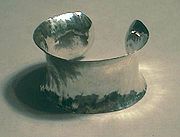
Raising (metalwork)
Encyclopedia

Metalworking
Metalworking is the process of working with metals to create individual parts, assemblies, or large scale structures. The term covers a wide range of work from large ships and bridges to precise engine parts and delicate jewelry. It therefore includes a correspondingly wide range of skills,...
technique whereby sheet metal
Sheet metal
Sheet metal is simply metal formed into thin and flat pieces. It is one of the fundamental forms used in metalworking, and can be cut and bent into a variety of different shapes. Countless everyday objects are constructed of the material...
is formed over a stake or other solid object by repeated sequences or "passes" of hammering and annealing
Annealing (metallurgy)
Annealing, in metallurgy and materials science, is a heat treatment wherein a material is altered, causing changes in its properties such as strength and hardness. It is a process that produces conditions by heating to above the recrystallization temperature, maintaining a suitable temperature, and...
of the metal, thereby compressing and thickening the steel into the desired shape. This technique is an essential part of metalworking; among other uses, it was used in creating medieval plate armour
Plate armour
Plate armour is a historical type of personal armour made from iron or steel plates.While there are early predecessors such the Roman-era lorica segmentata, full plate armour developed in Europe during the Late Middle Ages, especially in the context of the Hundred Years' War, from the coat of...
, and is also used to create fine silver
Silver
Silver is a metallic chemical element with the chemical symbol Ag and atomic number 47. A soft, white, lustrous transition metal, it has the highest electrical conductivity of any element and the highest thermal conductivity of any metal...
ware.
In traditional raising, sometimes referred to as Synclastic raising, the dominant curves of the object being forged are at right angles and move in the same direction; as in a bowl. This results in a surface possessing elliptic geometry
Elliptic geometry
Elliptic geometry is a non-Euclidean geometry, in which, given a line L and a point p outside L, there exists no line parallel to L passing through p. Elliptic geometry, like hyperbolic geometry, violates Euclid's parallel postulate, which can be interpreted as asserting that there is exactly one...
.
Anticlastic raising, on the other hand, refers to shaping an object where the dominant axes move in opposite directions; a familiar example of this is a potato chip
Potato chip
Potato chips are thin slices of potato that are deep fried...
. This results in a surface possessing hyperbolic geometry
Hyperbolic geometry
In mathematics, hyperbolic geometry is a non-Euclidean geometry, meaning that the parallel postulate of Euclidean geometry is replaced...
.
Raising should not be confused with the other common technique for forging three-dimensional objects from two-dimensional stock, sinking where the metal is streached to achieve the desired shape.

